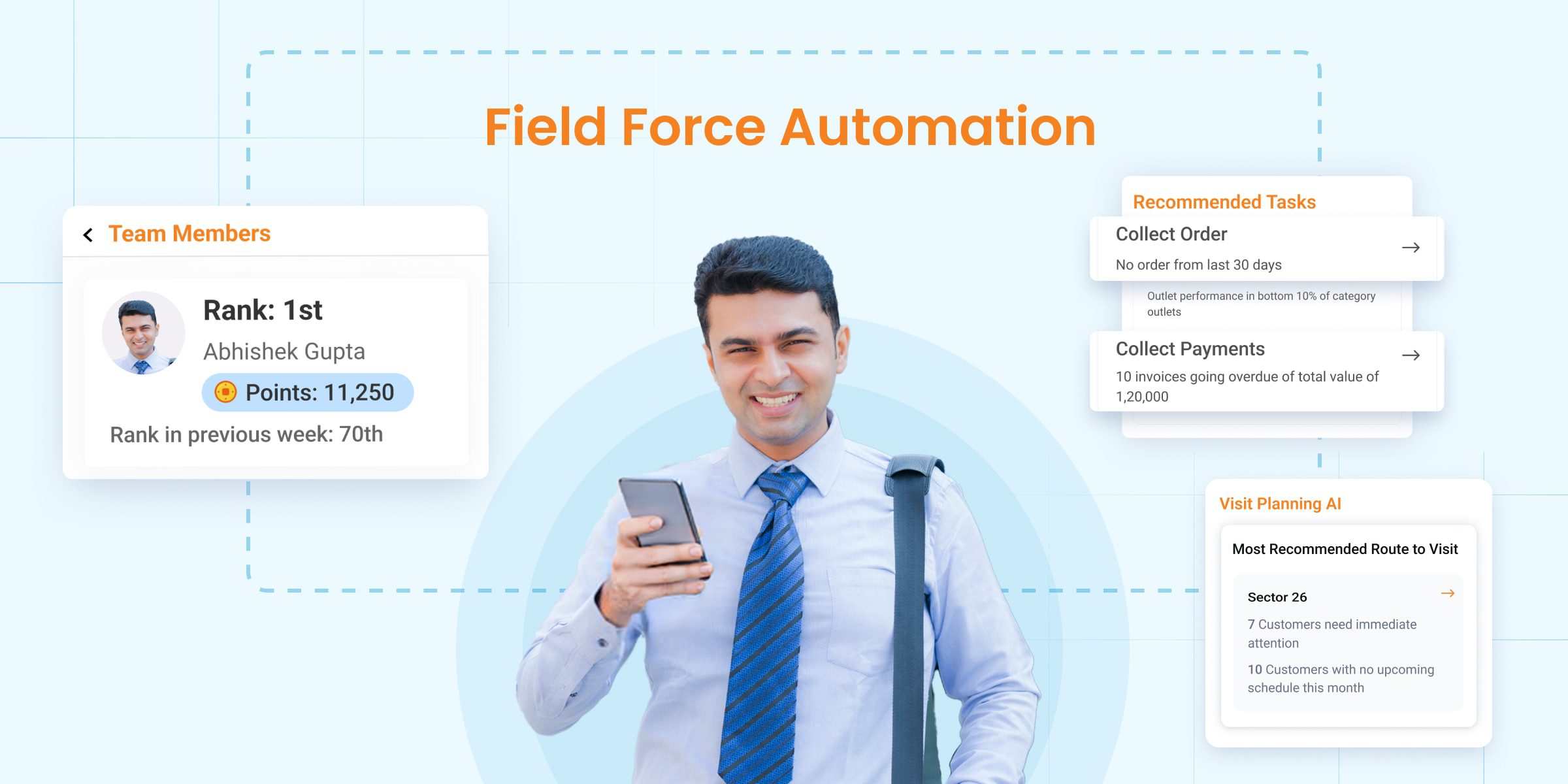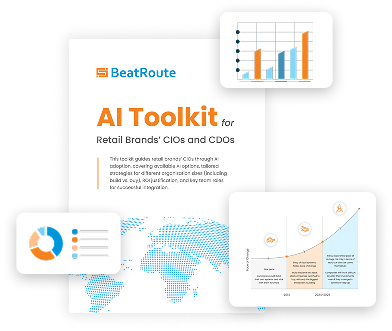Maximising ROI with Field Force Automation Software: A 2025 Guide

Recall the era when sales processes involved heaps of paperwork, tedious manual tracking, and an overload of spreadsheets. For years, businesses relied on these traditional methods to manage field operations, but let’s face it: they were time-consuming, error-prone, and often far from efficient.
Today, businesses can streamline these processes using various technologies. One such tool is Field Force Automation (FFA) software, which allows sales teams to digitize and optimize field operations, minimizing manual tasks and boosting efficiency. By automating activities like route planning, order management, and activity tracking, FFA software helps teams work more effectively, make informed decisions, and focus on key responsibilities.
In this guide, we’ll dive into what Field Force Automation software is, the key features to look for, its real-world impact, and how your business can implement it to streamline field activities, increase sales productivity, and reduce operational costs.
What is Field Force Automation Software?
Field Force Automation (FFA) or Sales Force Automation (SFA) software, is a tool designed to streamline field sales operations by automating tasks such as route planning, order management, activity tracking, and customer interactions. This automation reduces manual workloads and enhances the efficiency of field teams.
By eliminating the need for paper-based processes and manual data entry, FFA software ensures that field teams are always on top of their tasks, improving overall productivity.
Leveraging AI-driven insights, FFA recommends optimal stores to visit, suggests SKUs tailored to retailer profiles, and prioritizes critical tasks like pending payments and underperforming accounts, ensuring sales teams focus on high-impact activities for improved outcomes.
Industry experts suggest that field force automation can boost sales by 30% and cut down the time spent on sales management tasks by 14%. In fact, according to Harvard Business Review, automation in field sales results in a 20% increase in service-level agreement compliance and a 23% improvement in productivity.
Core Features to Look for in Field Force Automation Software
1. Territory & Route Optimisation
Efficient routing significantly reduces travel time and costs, maximising the number of productive visits. It allows you to create optimised routes that consider factors such as store classifications, visit frequencies, and real-time constraints. This strategic approach ensures that sales representatives spend more time engaging with high-priority retailers, enhancing relationships and driving sales performance.
2. Intelligent Visit Planning
AI-driven visit planning enhances sales efficiency by analysing real-time data such as sales performance, order patterns, payment statuses, and trade campaign outcomes. This analysis enables sales teams to prioritise visits to customers based on factors like sales volume achievement, order recency, payment status, and engagement in trade promotions. By focusing on these prioritised customers, sales representatives can adjust their visit schedules to ensure timely attention to high-priority clients, ultimately enhancing their daily operations.
Learn more about how BeatRoute’s Help Me Plan AI can help you streamline and simplify visit schedules effectively.
3. Gamification & Sales Enablement
Incorporating incentives and leaderboards significantly boost motivation among field teams, aligning their efforts with company objectives. By introducing gamification strategies, organisations can drive sales representatives toward clear, measurable goals, leading to noticeable improvements in team performance and engagement.
4. Mobile Order Management
Real-time mobile ordering streamlines transactions, reduces errors, and ensures timely stock replenishment. Field teams can instantly capture orders digitally, simplifying communication with distributors and warehouses.
4. Conversational AI & Intelligent Insights
Conversational AI empowers managers and sales reps to quickly access business-critical insights through natural-language queries, significantly reducing the time required for data analysis.
Why Do Businesses Need Field Force Automation?
Field Force Automation (FFA) software helps retail brands tackle challenges like manual errors, inefficient planning, and low productivity.
For example, a retail brand in FMCG with a large field team may struggle with managing routes, tracking orders, and updating customer information manually. FFA automates these tasks, allowing reps to focus on high-value activities like closing deals and improving efficiency.
Similarly, a retail brand in the consumer durables space can leverage FFA software to spot low stock levels at a key store and quickly adjust their visit plan to restock, preventing missed sales opportunities.
While FFA can significantly boost sales and operations, many retail brands hesitate to adopt it due to a lack of awareness about the challenges it can solve.
In the next section, we’ll dive into specific use cases that show how FFA improves both sales productivity and operational efficiency.
Top Field Force Automation Use Cases for Retail Brands
- Optimised Route Planning
FFA software helps field teams create efficient routes, reducing travel time and fuel costs while increasing visit frequency to high-priority locations. - Real-Time Data Access
Field reps can instantly access up-to-date customer, inventory, and sales data, enabling faster decision-making and more relevant interactions. - Enhanced Order Management
The tool automates order-taking process, ensuring accurate, timely order fulfillment with fewer errors and delays. - Improved Sales Tracking and Reporting
Managers gain real-time visibility into sales performance, helping them make informed decisions and adjust strategies for optimal results. - Automated Customer Interactions
Automates follow-ups, reminders, and promotional offers, ensuring timely and consistent communication with customers. - Stock and Inventory Management
Allows field reps to check stock levels and automatically place replenishment orders, preventing out-of-stock situations and lost sales. - AI-Driven Product Recommendations
AI helps sales teams suggest the right products to customers based on preferences, trends, and purchase history, boosting cross-sell and upsell opportunities. - Visit Prioritisation
FFA software uses AI to prioritise visits based on customer potential and geographic proximity, ensuring field teams focus on the highest-value tasks. - Lead Management
In addition to optimising retail execution, FFA systems efficiently capture and monitor leads, ensuring that every potential opportunity is pursued, while automating follow-ups to effectively convert leads into sales. - Enhanced Collaboration and Communication
It centralises communication between field teams and managers, ensuring real-time updates, seamless coordination, and a unified approach. - Data-Driven Performance Insights
FFA provides actionable insights into field team performance, customer engagement, and sales data, allowing for continuous improvement. - Flexible Field Force Management
Enables managers to monitor field team activities remotely, adjust schedules, and allocate resources based on real-time demand and performance. - Compliance and Documentation
FFA software ensures that all required documentation, such as invoices and receipts, are automatically generated and stored, ensuring compliance with industry standards and reducing the risk of errors or omissions.
Real Business Impact of Field Force Automation
The effectiveness of Field Force Automation software is measured by tangible business outcomes. BeatRoute’s Sales Impact Report (2025) highlights significant gains for customers who adopted Goal-Driven AI (GDAI) powered by Operational and Conversational AI:
| Impact Area | Key Results Reported (2024) |
|---|---|
| Sales Uplift through GDAI | 12.6% increase in monthly sales |
| Operational AI (Visit Planning, Order Recommendations) | 4.3% increase in productive visits and order values |
| Conversational AI (CuesBot) deployment | 10% increase in sales from actionable insights |
| Streamlined Network Expansion efforts | 16% uplift in sales through improved onboarding and pipeline management |
BeatRoute’s GDAI bridges the gap between process automation and measurable sales growth, directly linking software deployment to business outcomes.
How to Successfully Implement Field Force Automation Software
Implementing field force automation software successfully involves strategic planning and execution. Follow these steps to ensure a smooth transition and measurable success:
- Define Clear Objectives
Identify key business goals you aim to achieve with field force automation software. - Evaluate and Select the Right Software
- Choose solutions tailored to your industry needs.
- Look for AI capabilities, scalability, and ease of integration.
- Ensure Data Hygiene and Integration
- Standardise and integrate data from multiple sources.
- Utilise platforms that consolidate field and sales data seamlessly.
- Training and Adoption
- Conduct structured onboarding and training programs.
- Ensure user-friendly interfaces and robust support systems.
- Monitor and Optimise
- Continuously track key metrics.
- Use insights to refine strategies and optimise outcomes.
Common Pitfalls and How to Avoid Them
- Neglecting Data Quality: Ignoring data accuracy and integration can lead to flawed AI-driven insights and poor decision-making. Invest in clean, integrated data from the start to ensure reliable results.
- Overlooking Employee Adoption: Without proper training, field teams may struggle with navigation, or miss on key features. Provide thorough training and clear demonstrations of benefits to the field team.
- Rigid Software Selection: Relying on software that doesn’t offer flexibility or customisation can hinder your ability to scale or adapt to changing business needs, leaving you stuck with a system that no longer meets your requirements as your business evolves. Choose software that offers flexibility and customisation to adapt as your needs evolve.
- Lack of Clear Objectives: Not setting clear goals or KPIs can make FFA ineffective. Set measurable KPIs and track performance consistently.
- Failing to Monitor and Optimise: Overlooking ongoing optimisation can hinder progress. Regularly track performance and refine processes for maximum impact.
Trends in Field Force Automation for 2025 and Beyond
Looking forward, the following trends are shaping the future of field force automation:
- AI-Driven Personalisation: Customised, data-driven recommendations tailored to individual team members.
- Unified Platforms: Businesses are moving away from disconnected SaaS tools towards integrated platforms to improve data integrity and operational efficiency.
- Enhanced Conversational AI: Expanding capabilities of conversational tools like BeatRoute’s CuesBot for intuitive, real-time decision-making.
How to Choose the Right Field Force Automation Software
- Scalability and Flexibility: Consider future growth and flexibility in handling evolving business needs.
- User-Friendliness: The software should be intuitive and easy for your field teams to use, with minimal training required.
- Ease of Integration: Ensure the FFA tool easily integrates with your existing business tools (CRM, ERP) for seamless data flow.
- Industry-Specific AI Customisations: Ensure the solution is capable of handling industry-specific use cases (e.g., FMCG, Pharma, Building Materials).
- Data Security and Compliance: Robust measures to ensure secure handling of sensitive field data.
- Vendor’s Commitment to Customer Success: Evaluate ongoing support, implementation guidance, and continuous product enhancements.
Transform Your Field Operations with FFA
As businesses continue to evolve, FFA is key to staying competitive, offering real, measurable improvements in efficiency and sales performance.
Adopting Field Force Automation Software is a game-changer for industries like FMCG, Pharma, Telecom, and Retail, where field teams are crucial to sales and customer satisfaction. It not only enhances team connectivity through a unified platform but also provides better visibility and transparency across operations.
BeatRoute’s Sales Force Automation (SFA), helps you streamline workflows, increase productivity, and make smarter, data-driven decisions while reducing costs and boosting customer satisfaction.
Schedule a personalised demo to see how BeatRoute’s SFA can help you cut travel time and double your field sales efficiency.
About the Author
-
Surya Panicker is the Head of Content at BeatRoute, where she leads content strategy for India’s goal-driven sales platform. With 9 years in marketing automation and SaaS, Surya specializes in building content that translates complex solutions into actionable business outcomes. Her approach combines data-driven insights with a storytelling mindset, always putting the customer at the center of her narratives. Surya focuses on aligning brand messaging with audience needs to deliver practical results. Outside of work, she enjoys exploring new cuisines, reading fiction, and traveling with her family.
Use Goal-Driven AI to Achieve Retail Sales Uplift, Today!
Join enterprises in 20+ countries that trust BeatRoute, the globally dominant AI platform for sales force automation, field sales, DMS, and eB2B
Latest Insights & Articles
Here are the most impactful articles, platform updates, ebooks and reports for you.



